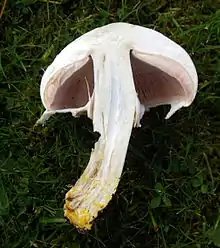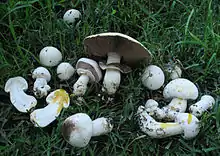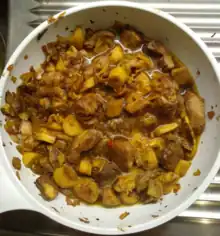Agaricus xanthodermus
Agaricus xanthodermus, commonly known as the yellow-staining agaricus,[2] yellow-staining mushroom or yellow-stainer,[3] is a mushroom of the genus Agaricus, which displays a strong yellow colouration at the base of the stem when cut. It has a phenolic smell. It is poisonous for most people, causing gastrointestinal upset, but can be eaten by some without apparent negative effect.
| Agaricus xanthodermus | |
|---|---|
 | |
| Scientific classification | |
| Domain: | Eukaryota |
| Kingdom: | Fungi |
| Division: | Basidiomycota |
| Class: | Agaricomycetes |
| Order: | Agaricales |
| Family: | Agaricaceae |
| Genus: | Agaricus |
| Species: | A. xanthodermus |
| Binomial name | |
| Agaricus xanthodermus Genev. (1876) | |
| Synonyms[1] | |
| Agaricus xanthodermus | |
|---|---|
| Gills on hymenium | |
| Cap is convex | |
| Hymenium is free | |
| Stipe has a ring | |
| Spore print is brown | |
| Ecology is saprotrophic | |
| Edibility is poisonous | |
Taxonomy
This species was first officially defined under the name Agaricus xanthodermus in 1876 by Léon Gaston Genevier, in a letter published in the bulletin of the French Botanical Society.[4][5] Genevier described the Agaricus mushrooms commonly eaten (perhaps sometimes inadvisedly) in the region of Nantes, and attempted to clarify the distinctions between them. He proposed a detailed reclassification into 5 species, including this new one. Apparently up until that time, these yellow-staining mushrooms were considered to be just varieties of other species which are edible: A. arvensis, A. edulis, and A. silvicola.[6]
The epithet xanthodermus is derived from the Ancient Greek words for "yellow" and "skin", which were then given a Latin adjective ending. This is the official name, but the form Agaricus xanthoderma is also often seen.[7][8][9] In the latter name, -derma "skin" is a neuter noun which does not have to agree in gender with Agaricus, and so this form is legal according to the rules of botanical nomenclature.[10]
Description

The cap ranges from 5–15 cm (2–6 in) in diameter.[11] It is initially convex, with some young specimens having a squarish shape, though flattening with age. It is whitish, with light brown tints towards the centre. The cap is dry and smooth, but can be scaly when old. The gills of this mushroom progress from pale-pink to a chocolate color. Its white stipe measures 5–12 cm (2.0–4.7 in) tall and 1–3 wide,[11] and is bulbous with a skirt-like ring. Microscopically, the cheilocystidia are club-shaped. The spores are brown, elliptical, and smooth,[11] measuring 6–7 × 3–4 µm.
The main identifying feature is an immediate bright yellow colouration on cutting through the base of the stem, or scraping the flesh; later, the affected area fades to a dull brown. Numerous edible Agaricus species, such as A. augustus, A. arvensis and A. silvicola, turn yellow to a greater or lesser extent, but they do not display such an intense reaction.

Agaricus xanthodermus has an unpleasant characteristic smell, which is phenolic, reminiscent of ink or carbolic soap. The smell is especially strong at the base of the stem. On cooking, the smell becomes very noticeable, and this may deter people from eating it inadvertently.[12]
Distribution and habitat
This mushroom is very common and widely distributed in North America, Europe, West Asia including eastern Anatolia[13] and Iran,[14] North Africa,[8] and southern Africa.[15] It has been introduced into Australia. It occurs in woods, lawns, gardens and hedgerows in autumn. This is a saprobic species.
Toxicity
Although it appears that some people can eat this mushroom without ill effects,[3][6][12] it contains toxins which can cause serious gastric problems.[16] It is indigestible and gives rise to symptoms of sweating, flushing, and severe stomach cramps.[3][7][12]
Of those who gather Agaricus-style mushrooms, about 50% of the cases of poisoning are from this species.
Related species
Agaricus xanthodermus belongs to a group of related species (the "Xanthodermati") which likewise discolour bright yellow and have a phenolic smell. They include A. praeclaresquamosus (formerly A. placomyces) which has dark grey scales, A. moelleri, and A. pilatianus, which does not have a bulbous stem.[8]
Agaricus californicus is also similar in appearance.[11]
See also
References
- "Agaricus xanthodermus Genev". Species Fungorum. CAB International. Archived from the original on 2018-07-03. Retrieved 2015-09-10.
- Arora, David (1986). Mushrooms demystified: a comprehensive guide to the fleshy fungi (Second ed.). Berkeley: Ten Speed Press. ISBN 978-0-89815-169-5.
- Roger Phillips. "Agaricus xanthodermus". Archived from the original on 2013-06-16. Retrieved 2012-07-19.
- Nowadays there is also a French Mycological Society Archived September 28, 2012, at the Wayback Machine, but in 1876 fungi were considered under botany.
- See the entry in Index Fungorum.
- Genevier L. G. (1876). "Étude sur les champignons consommés à Nantes sous le nom de champignon rose ou de couche (Agaricus campestris L.)". Bulletin de la Société Botanique de France (in French). 23: 28–35. doi:10.1080/00378941.1876.10825614. The paper is available on-line here. On page 32 it is stated that some people can eat A. xanthodermus with impunity.
- "Marcel Bon (1987). The Mushrooms and Toadstools of Britain and North-Western Europe. Hodder & Stoughton. p. 278. ISBN 0-340-39935-X."
- Courtecuisse, R. & Duhem, B. (1994). Guide des champignons de France et d'Europe. Delachaux et Niestlé. p. 258. ISBN 2-603-00953-2. Also available in English.
- See Meinhard Moser (1983). Keys to Agarics and Boleti. Translated by Simon Plant. London: Roger Phillips. p. 238. ISBN 0-9508486-0-3.
- Binomial names may take the form "noun + adjective", "noun + nominative noun" or "noun + genitive noun" as explained in this section of the Binomial nomenclature article. There is agreement in gender only in the "noun + adjective" case (as in Agaricus xanthodermus, which means something like "yellow-skinned Agaricus"), but Agaricus xanthoderma is the second type (like "Agaricus yellow-skin") and there the endings do not agree. Another similar example is Agaricus silvicola (which means "Agaricus, inhabitant of the woods").
- Davis, R. Michael; Sommer, Robert; Menge, John A. (2012). Field Guide to Mushrooms of Western North America. Berkeley: University of California Press. p. 230. ISBN 978-0-520-95360-4. OCLC 797915861.
- Peter Jordan (2000). The Mushroom Guide and Identifier: The Ultimate Guide to Identifying, Picking and Using Mushrooms. London: Hermes House. p. 100. ISBN 1-84038-574-X.
- Demirel K, Uzun Y, Kaya A (2004). "Some Poisonous Fungi of East Anatolia" (PDF). Turk J Bot. 28: 215–19. Archived from the original (PDF) on 2005-05-05. Retrieved 2008-02-08.
- Asef Shayan, M.R. (2010). قارچهای سمی ایران (Qarch-ha-ye Sammi-ye Iran) [Poisonous mushrooms of Iran] (in Persian). Iran shenasi. p. 214. ISBN 978-964-2725-29-8.
- Van der Westhuizen, GCA and Eicker, A (1994) Mushrooms of Southern Africa, Field Guide. Struik Publishers, Cape Town.
- Miller Jr., Orson K.; Miller, Hope H. (2006). North American Mushrooms: A Field Guide to Edible and Inedible Fungi. Guilford, CN: FalconGuide. p. 276. ISBN 978-0-7627-3109-1.
- Collins Gem Guide: Mushrooms and Toadstools, Stefan Buckzacki (1982).
 Media related to Agaricus xanthodermus at Wikimedia Commons
Media related to Agaricus xanthodermus at Wikimedia Commons Data related to Agaricus xanthodermus at Wikispecies
Data related to Agaricus xanthodermus at Wikispecies